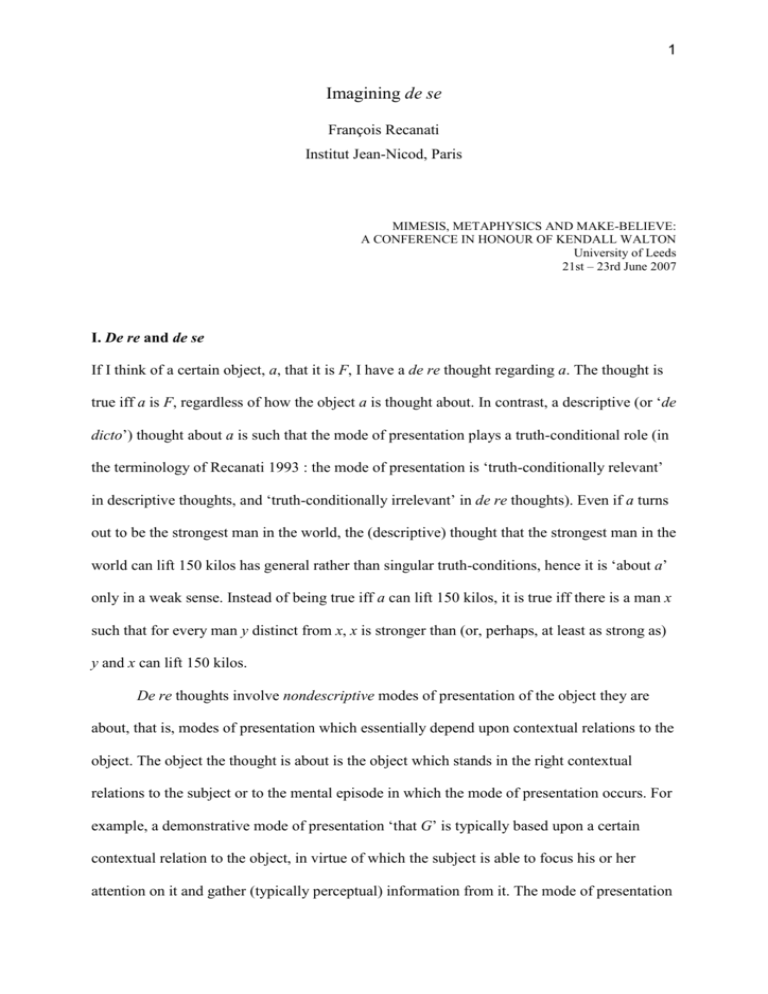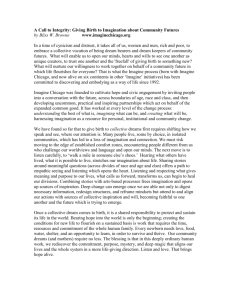Chapter 23
advertisement

1 Imagining de se François Recanati Institut Jean-Nicod, Paris MIMESIS, METAPHYSICS AND MAKE-BELIEVE: A CONFERENCE IN HONOUR OF KENDALL WALTON University of Leeds 21st – 23rd June 2007 I. De re and de se If I think of a certain object, a, that it is F, I have a de re thought regarding a. The thought is true iff a is F, regardless of how the object a is thought about. In contrast, a descriptive (or ‘de dicto’) thought about a is such that the mode of presentation plays a truth-conditional role (in the terminology of Recanati 1993 : the mode of presentation is ‘truth-conditionally relevant’ in descriptive thoughts, and ‘truth-conditionally irrelevant’ in de re thoughts). Even if a turns out to be the strongest man in the world, the (descriptive) thought that the strongest man in the world can lift 150 kilos has general rather than singular truth-conditions, hence it is ‘about a’ only in a weak sense. Instead of being true iff a can lift 150 kilos, it is true iff there is a man x such that for every man y distinct from x, x is stronger than (or, perhaps, at least as strong as) y and x can lift 150 kilos. De re thoughts involve nondescriptive modes of presentation of the object they are about, that is, modes of presentation which essentially depend upon contextual relations to the object. The object the thought is about is the object which stands in the right contextual relations to the subject or to the mental episode in which the mode of presentation occurs. For example, a demonstrative mode of presentation ‘that G’ is typically based upon a certain contextual relation to the object, in virtue of which the subject is able to focus his or her attention on it and gather (typically perceptual) information from it. The mode of presentation 2 can be thought of as a temporary mental file in which the subject can store the information acquired in virtue of the contextual relation in question.1 According to Perry, the concept of self is a special case. It is a mental file that is based upon a special relation which every individual bears to himself or herself, namely identity. In virtue of being a certain individual, I am in a position to gain information concerning that individual in all sorts of ways in which I can gain information about no one else, e.g. through proprioception and kinaesthesis. The mental file ‘self’ serves as repository for information gained in this way — the first person way — as well as for any information that is about the same individual as information gained in this way). On this view, de se thoughts are a particular case of de re thought (Figure 1). A de se thought is a de re thought about oneself, that involves a particular mode of presentation, namely a first person mode of presentation. As Frege wrote in ‘The thought’, « every one is presented to himself in a particular and primitive way, in which he is presented to no one else » (Frege 1918-19 : 25-6). One may entertain a de re thought about oneself that does not involve such a mode of presentation, as in Kaplan’s famous mirror example. Kaplan’s example involves a man pointing to himself in the mirror and saying (or thinking) ‘His pants are on fire’, without realizing that he is the man whose pants are on fire. This is an ‘accidental’ de se thought. It is a de re thought about the thinking subject, but not one that involves a first person mode of presentation. It is only accidentally about the subject. It contrasts with genuine de se thoughts, that is, thoughts which one would express by using the first person : ‘My pants are on fire’. Such thoughts I call ‘first person thoughts’. 1 See Recanati 1993, 2005, and 2006 for a more detailed presentation of this familiar account. 3 De re thoughts About something other than oneself about oneself Accidentally de se First-person thoughts Figure 1 II. Immunity to error through misidentification So far I have drawn three distinctions : a first distinction between descriptive thoughts and de re thoughts ; a second distinction, among de re thoughts, between those that are about oneself and those that are about something other than oneself ; and a third distinction, within the category of thoughts about oneself, between those that are genuinely de se (first person thoughts) and those that are accidentally so. There is a fourth distinction which forces us to give up the claim that de se thoughts are a variety of de re thoughts. De re thoughts typically give rise to what Jerry Fodor called ‘Frege cases’ (Fodor 1994 : 22-25). The Kaplan example is one such case : the subject entertains a de re thought about himself, under the mode of presentation ‘that man (in the mirror)’ ; but he does not realize that it is himself that the thought is about. He wrongly believes ‘that man myself’. In a similar type of case, the subject wrongly takes a current thought of his to be about himself, while it is about some distinct object. Wittgenstein famously discussed one such example. « It is possible that, say in an accident, I should feel a pain in my arm, see a broken arm at my side, and think it is mine, while in fact it is my neighbour’s » (Wittgenstein 1958 : 67). Because the subject mistakenly identifies the arm he sees as his own arm, he wrongly believes that his own arm is broken. 4 The fourth distinction I announced above is that which, in the passage from the Blue Book where he introduces the broken arm example, Wittgenstein draws between two types of first-person thought : those that are (in Shoemaker’s later terminology) vulnerable to ‘error through misidentification’ — Wittgenstein’s example being the thought ‘my arm is broken’ in the described circumstances — and those that are immune to such error. For example, if I feel pain and judge ‘I am in pain’, I cannot be mistaken as to the person who happens to be in pain. According to Evans, and many authors following him, such thoughts are immune to misidentification because they do not rest on an identification ; they are ‘identification-free’. One way of understanding identification-freedom is as follows (Recanati 2007). Immunity to error through misidentification characterizes thoughts that are ‘implicitly’ de se, as opposed to thoughts that involve an explicit self-identification. Thoughts that are implicitly de se involve no reference to the self at the level of content: what makes them de se is simply the fact that the content of the thought is evaluated with respect to the thinking subject. Or, to put it in familiar terms : the content of the thought is a property which the thinking subject self-ascribes (Loar 1976 : 358 ; Lewis 1979; Chisholm 1979, 1981). Thus the content of the subject’s self-ascription of pain is something like ‘being in pain’ : a content that is true at a person if and only if the person in question is in pain. The subject serves as circumstance of evaluation for that content, rather than being a constituent of it. In contrast, an explicit de se thought is a thought the (explicit) content of which involves an ‘identification component’, through which the object thought about is identified as oneself. The subject who sees himself in the mirror and thinks ‘My arm is broken’ entertains such a thought, and explicitly thinks of the person whose arm is broken as being herself. (Evans represents the content of the thought as a conjunction : Someone’s arm is broken, and I am that person.) In this framework, not all de se thoughts are de re thoughts. Implicit de se thoughts are not ‘about’ the subject, but merely ‘concern’ him or her (Perry 1986). As a result, they 5 cannot give rise to Frege cases, as de re thoughts typically do. Only de se thoughts in which the self is explicitly represented give rise to Frege cases. We end up with a threefold taxonomy (Figure 2). First, there are accidental de se thoughts, namely de re thoughts about an individual x who happens to be oneself. Second, there are genuine de se thoughts — the sort of thought one expresses by using the first person and which, for that reason, I call ‘first-person thoughts’. In this category we must distinguish between explicit and implicit de se thoughts. Explicit de se thoughts are a variety of de re thought and give rise to Frege cases, while implicit de se thoughts are not and do not. De re thoughts About something other than oneself First-person thoughts about oneself Accidentally de se Explicitly de se Implicitly de se Figure 2 III. Ascribing de se thoughts Let us consider the following sentences, which report John’s expectation regarding his own career : (1) Johni expects that hei will be elected (2) John expects that he himself will be elected (3) John expects to be elected 6 In (1), the ascription may be interpreted transparently. On that (unlikely) reading we are told that John expects, concerning some individual who happens to be John himself, that he will be elected, but we are not told how he thinks of that individual. The ascription may also and will typically be interpreted ‘opaquely’, in the sense that the speaker may overtly intend (or expect) the hearer to identify a particular mode of presentation as being that under which John thinks of himself in the reported thought episode. For example, it may be contextually manifest that (1) is meant to report a first-person thought of John’s. What (1) contextually says, on that reading, is that John has an expectation he might express by saying ‘I will be elected’. But the contextually specified mode of presentation may not be a first person mode of presentation. It may be contextually clear that John’s expectation concerns the man now speaking on TV, who (unbeknown to John) happens to be John himself. On that reading what (1) contextually says is that John expects that man (who happens to be himself) to be elected. Here John might express his expectation by saying ‘That man will be elected’, but not by saying ‘I will be elected’. (We can construct a scenario in which John expects the man he sees on TV to be elected, but does not himself expect to be elected.) It is often said that the emphatic reflexive ‘he himself’ in (2) disambiguates (1) and imposes the first-person reading. On this view (2) can only report a thought John himself would express by saying ‘I will be elected’ (see e.g. Corazza 2004: 280-281). In the first paper ever written on this topic, Geach described ‘he himself’, so interpreted, as « an oratio obliqua proxy for the first person pronoun of oratio recta » (Geach 1957 : 129). Some years later Castañeda devoted a series of papers to such proxies, which he dubbed ‘quasi-indicators’ (see Castañeda 1999). A quasi-indicator not only imposes an opaque interpretation of the report it occurs in, but imposes a specific opaque interpretation such that the ascribee thinks of the object his thought is about in the first person way. 7 I agree that (2) strongly suggests that what is being reported is a first person thought, because it is hard to interpret the emphatic reflexive otherwise. But this interpretation is not, strictly speaking, mandatory. (Nor have Geach or Castañeda ever claimed that it was.) One can imagine contexts in which (2) would not report a first person thought, and that shows that ‘he himself’ is not a ‘quasi-indicator’ in virtue of the rules of the language, but simply has quasi-indicator uses, like the unadorned third person pronoun ‘he’.2 If this is true, then the difference between (1) and (2) is not as great as one may have thought. Still, there is a way of disambiguating (1) and imposing the first person reading by purely linguistic means. As various authors have argued, following Chierchia (1989), what distinguishes sentence (3) from (1), and perhaps also from (2), is that (3) can only be interpreted as opaquely ascribing a first person thought. Sentence (3) is usually analysed as involving a covert anaphoric element, PRO, as subject of the infinitive clause, with the subject of the main clause as antecedent. So (3) says that John expects PRO to be elected, where PRO inherits its reference from the antecedent ‘John’. Besides being anaphoric on the subject of the higher clause, a second essential feature of PRO is that it imposes an interpretation of the complement clause as denoting a first person thought. The expectation which (3) ascribes to John is an expectation John himself would express by saying : ‘I will be elected.’ 2 The following example, discussed on the blog ‘Thoughts Arguments and Rants’ in February 2004 (http://tar.weatherson.org/2004/01/30/de-se-desire-reports/), shows that the emphatic reflexive is not always used as a Castañedan quasi-indicator : « While running a race, Bill is watching a race (on his video sunglasses) among three participants. Unbeknownst to him, he’s actually watching the race he’s running, and the runner he favors is actually himself. Though he doesn’t know it, he wants himself to win. » 8 What I have just said suggests that the construction with PRO can only be used to report first person thoughts. But this is far from capturing the specific import of the construction. In what follows, I argue that the construction’s only use is to report implicit de se thoughts. IV. PRO and the implicit-de se reading Consider the semantic difference between (4) and (5), which uses a variant of the construction with PRO (with a gerund instead of an infinitival clause) : (4) He remembers himself delivering a speech to the salesmen (5) He remembers delivering a speech to the salesmen To make out the difference, imagine the following context. Suppose the subject, A, was filmed delivering a speech to an assembly of salesmen. He retained no memory of that experience, but, having recently seen the film, remembers the episode from the film. At this point there are two possibilities : he may have identified himself as the person in the film, or he may not. If he has, this corresponds to the ‘explicit de se’ type of case. The thought is de se, but subject to error through misidentification. (The subject may have been wrong in identifying himself with the character in the film.) If he has not identified himself as the person in the film, this corresponds to the ‘accidental’ type of case : the subject who remembers the scene in the film remembers himself giving the speech, without realizing it is himself that his memory (and the film) is about. Sentence (4) is compatible with both cases, and it is also compatible with the case in which the subject has retained first person memories of the original experience, without the mediation of the film. (As we shall see, this corresponds to the ‘implicit de se’ type of case.) 9 If we turn to (5), we see that the ‘accidentally de se’ interpretation is ruled out (Higginbotham 2003a : 510-512). If the subject does not realize that it is himself who gives the speech in the scene he remembers from the film, we will not say that he ‘remembers delivering the speech’. But there is more : the case in which the subject has identified himself as the character in the film but lacks first person memories of the original experience is also ruled out. We would not say ‘He remembers giving a speech to the salesmen’ if what he actually remembers is seeing, in the film, the character who he takes to be himself delivering a speech to the salesmen. We would rather say : ‘He remembers himself delivering a speech to the salesmen’. So it seems to me that only the interpretation in which the subject has retained first person memories of the original experience is compatible with the construction in (5). What is common to the two types of case which (5) rules out (the accidental case and the explicit-de se case) ? In both, the subject views himself from an external or objective point of view. The subject who remembers himself from the film, whether or not he has identified the character in the film as himself, views himself ‘from outside’, as a spectator does. In contrast, the subject who directly remembers giving the speech to the salesmen, without the mediation of the film, does not view himself from an objective point of view : he subjectively remembers what it was like to give the speech. He remembers the action ‘from inside’. According to Vendler (1979), who discussed an analogous example involving the imagination, the contrast between the internal and the external point of view is somewhat misleading. The objective, Vendler argued, is nothing but a special case of the subjective. Indeed, episodic memory — the sort of memory that is being reported in our example — is always memory of an experience, hence something subjective and perspectival. But in one type of case the experience is, directly, the experience of giving the speech to the salesmen, while in the other type of case the experience is that of seeing the character in the film giving 10 a speech to the salesmen. In all cases the experience is intrinsically subjective, but in one type of case the person giving the speech stands as an ‘object’ in the subjectively experienced scene, while in the other type of case the person giving the speech is not ‘in’ the remembered scene : he is (only) the experiencer — the person whose experience is remembered — and has the same status as that of the spectator of the film. Given all this, my suggestion is that the PRO construction (or family of constructions) imposes the ‘implicit de se’ reading. What characterizes that reading is the fact that the subject whose thought is being reported is not a constituent of the content of the reported thought. In the case of (5), the subject is not a constituent of the remembered scene – he is not an object in that scene, contrary to what happens in both the ‘accidental’ and the ‘explicit de se’ readings of (4). Not being a constituent of the scene represented, the subject himself cannot be construed objectively and can only have the role of the person from whose point of view the scene is experienced. So (5) ascribes a memory the content of which is an activity (giving a speech to the salesmen). The agent is not explicitly represented — not even impersonally — only the activity is ; yet, by remembering that activity in the episodic mode (i.e., as something experienced), the subject implicitly ascribes it to himself (or, rather, to his former self). One can only remember one’s own experiences. Here, what guarantees the subject’s involvement is the mode, not the content of the state (Recanati 2007). V. Walton’s challenge We find the same type of contrast between (6) and (7) as we found between (4) and (5) : (6) John imagined himself giving a speech to the salesmen (7) John imagined giving a speech to the salesmen 11 Like (5), (7) can only have a reading where what is imagined is imagined ‘from inside’. The imaginer puts himself in the shoes of the person giving the speech and feels, or tries to (imaginatively) feel, like that person undergoing the relevant experience. In the case of memory we saw that, in contrast to (5), (4) was compatible with ‘objective’ memories mediated by the film. This seems to be true of (6) as well, in contrast to (7). I can certainly ‘imagine myself giving the speech’ from an objective, external point of view — by having the mental camera look at me from outside, as it were. This is phenomenologically different from imagining giving the speech. At the beginning of his paper on imagination, Vendler emphasizes the phenomenological difference between objective and subjective de se imaginings, corresponding to the contrast between (6) and (7). He gives a vivid example : We are looking down upon the ocean from a cliff. The water is rough and cold, yet there are some swimmers riding the waves. « Just imagine swimming in that water » says my friend, and I know what to do. « Brr ! » I say as I imagine the cold, the salty taste, the tug of the current, and so forth. Had he said « Just imagine yourself swimming in that water », I could comply in another way too : by picturing myself being tossed about, a scrawny body bobbing up and down in the foamy waste. In this case, I do not have to leave the cliff in imagination : I may see myself, if I so choose, from the very same perspective. Not so in the previous case : if I indeed imagine being in the water, then I may see the cliff above me, but not myself from it. (Vendler 1979 : 161) This illustrates what, following Vendler, I said earlier about the subjective and the objective : the objective imagination is a particular case of the subjective, namely the case in which the 12 subject imagines seeing himself swim in the water. In that special case the subject plays two roles : he is not only the experiencer, the person from whose point of view the scene is seen, but he is also an object in the scene. This duality enables the subject to look at himself (herself) from an external, third person point of view. In contrast, the subjective case is the case in which the subject only plays the role of experiencer : s/he is not an object, an aspect of what is represented. What is represented is only « the cold, the salty taste, the tug of the current, and so forth ». To sum up, I claim that in imagination reports as in memory reports, the construction with PRO imposes not only a first-person construal of the reported thought but more specifically a first-person construal of the implicit-de se type. The content of the reported state cannot feature the self among its ‘objective’ constituents : this accounts for the fact that (7) can only be given the ‘subjective’ interpretation where what is imagined is imagined from inside. Walton denies the data, however. He thinks the construction with PRO does not prevent the reported de se imagining from being of the ‘objective’ type : When Gregory imagines playing in a major league baseball game and hitting a home run, he may imagine this from the inside, imagine feeling in his hands the shock of the bat connecting with the ball, and so on. But suppose he imagines hitting the home run from the perspective of a spectator in the stands. He visualizes the scene from that point of view, and his image of the field includes Gregory as he slams the ball over the center field fence and rounds the bases. This imagining is, I believe, best classified as de se. It is perfectly natural to describe Gregory as imagining hitting a home run, and as imagining that he himself hits one. (Walton 1990 : 30). 13 I find this claim rather surprising. I agree with Walton that this is a first person imagination, which we can report by saying that Gregory imagines himself hitting a home run. But this is not an implicit de se imagining, and I would be reluctant to use the PRO construction. To be sure, matters of usage are complex and subtle, and I am the first to emphasize the flexibility of linguistic conventions. So let us consider the theoretical reasons Walton adduces in favour of his claim that « imagining de se is not always imagining from the inside » (Walton 1990 : 30). By ‘imagining de se’ here, Walton means something corresponding to the strongest of the three senses I have distinguished : the implicit-de se case. He notes that Gregory’s imagining, though objective, is immune to error through misidentification : « There is no room for doubt that [Gregory] is himself the player who hits the home run in his imagination » (id.) This fact arguably establishes that subjectivity and immunity are not two sides of the same coin, contrary to what I suggested. So, if Walton is right, one may accept that the PRO construction is only used to report first person thoughts that are identification-free, while rejecting the claim that the subject of such thoughts necessarily views things ‘from inside’. But if Walton is right, there no longer is any reason to maintain that the PRO construction is only used to report first person thoughts that are identification-free. For the only evidence I provided in favour of that claim was precisely the fact that the construction with PRO rules out all the cases in which the subject is viewed ‘from outside’. I exploited the link between the subjective perspective and identification-freedom to argue that the PRO construction imposes the implicit-de se reading. If the link is severed, the argument no longer goes through. 14 VI. Immunity to error without identification-freedom In response to Walton, I argue as follows. Whatever immunity to misidentification Gregory’s imagining enjoys in this case arguably derives from a general property of the imagination. What one’s perception or memory is about is determined by external factors of which we may be unaware, like the identity of the object which stands in the right causal-epistemic relation to us. With imagination, the situation is different. What determines what one’s imagination is about is not some external fact of which one may be unaware, but what Bernard Williams aptly called one’s ‘imaginative project’ (Williams 1973). So, when we turn from perception and memory to imagination, it seems that we lose the ‘accidental de se’ type of case, that is, the case in which I represent something about myself without realizing that it is myself whom the representation is about. If this is right, Gregory can hardly ‘imagine himself being F’ without realizing that it is himself whom he imagines being F. But this does not show that his imagining is identification-free. What it shows is simply that the sort of identification which takes place in explicit-de se imaginings is immune to error. Involving an identification that is immune to error is different from being identification-free, that is, not involving any identification at all. At this point, a caveat is in order. The ‘identification’ of the objects of one’s imagination is not absolutely immune to error. In certain circumstances, error remains possible. Walton himself makes that point: Wittgenstein observed that when a person imagines King’s College on fire, there may be no room for questioning his claim that it is King’s College which he imagines — even if another college or a Hollywood movie set perfectly matches his visual image (if he has one). Doubt about the identity of the imagined college is not entirely out of the question, however. If the imaginer has prevously mistaken another college for 15 King’s, and if his intention is to imagine that college, he may think the college he is imagining is King’s when it is actually the other one. If he saw King’s College without realizing it was King’s, he might then imagine King’s College on fire without realizing that King’s is the college he is imagining. (Walton 1990 : 29-30) This point applies to de se imaginings. As John Hawthorne pointed out to me, a subject may entertain a de re thought about himself (as in Kaplan’s mirror example), and imagine that person being F : that makes his self-imagination accidentally de se, though in a derivative manner. The claim that imagination does not allow for accidentally de se cases should therefore be qualified : no such case is possible unless the accidentally de se character of the imagining is inherited from a mental state in another mode than the imagination mode, through some kind of anaphoric link. Precisely because accidentally de se cases are not absolutely (but only conditionally) ruled out in virtue of general properties of the imagination, the identification at stake in (explicit) de se imaginings should not be absolutely (but only conditionally) immune to error : such errors ought to be possible, whenever the imagining is de se in virtue of certain causal antecedents, that is, in virtue of anaphoric connections to other mental states. But, Walton argues, No conceivable evidence about the causal antecedents of [Gregory’s] imaginative experiences could make him question that he is himself the player who hits the home run in his imagination. There seems to be no story of the relevant sort to be told about how it got to be Gregory whom he imagines… Yet his imagining is not from the inside. It is as though he is watching someone else hit the ball and round the bases, despite his unshakable realization that he is himself that person. (Walton 1990 : 30-31) 16 In other words, the immunity to error through misidentification which Gregory’s imagining enjoys is stronger than whatever derives from the general property of the imagination I mentioned above. If this is right, then Walton is entitled to maintain that we should make room for a class of de se imaginings which are both (i) immune to error through misidentification, yet (ii) objective (‘from outside’) rather than subjective (‘from inside’). If so, then the analysis I have put forward, according to which immunity and subjectivity derive from a single feature (the selflessness of content in implicit-de se cases), is mistaken. Fortunately for my analysis, I do not think Walton is right. For he has not shown the form of immunity which Gregory’s imagining enjoys to be stronger than that which derives from general properties of the imagination. As we have just seen, the identification of the objects of one’s imagination is immune to error unless it is inherited from some previous mental state through some sort of anaphoric link. Misidentification ought to be possible, I said, whenever the imagining is de se in virtue of certain causal antecedents, that is, in virtue of anaphoric connections to other mental states. In the example at stake, however, the identification of Gregory as the object his imagining is about is fixed directly by Gregory’s imaginative project, in a stipulative manner ; it is not determined by the causal antecedents of the imaginative state. If it were so determined (e.g. if Gregory’s project was to imagine that man in the mirror hitting a home run), then it might indeed give rise to Frege cases. I conclude that the sort of de se imagining which the Gregory example illustrates is not an implicit de se imagining. It is (conditionally) immune to error through misidentification because of a general property of the imagination, but it involves a form of identification nonetheless — a form of identification that is immune to error only because it is stipulative rather than anaphorically inherited. 17 VII. How egocentric is the imagination ? We have noted a difference between imagination reports and memory reports when it comes to the availability of ‘accidentally de se’ readings. This reflects a difference betwen the ways the object one one’s thought is determined in the case of imagination and in the case of memory (or perception). In this section and the next, I would like to focus on another revealing difference between memory and the imagination. That difference bears on another central issue which Walton raises : Is imagining from the inside necessarily imagining about oneself ? Yes, I take it… To imagine seeing a rhinoceros is to imagine oneself seeing a rhinoceros, not just to imagine an instance of rhinoceros seeing. One who imagines Napoleon’s seeing a rhinoceros, or imagines a seeing of a rhinoceros without imagining whose seeing it is, does not thereby ‘imagine seeing a rhinoceros’ as this phrase is ordinarily understood. … ‘Imagine’ fits a common pattern in this regard. To remember giving a speech is to remember oneself giving one, not merely to remember an instance of the speech being given. (Walton 1990 : 31) As far as memory is concerned, I agree. One can only remember one’s own experiences. So even if the content of the memory is selfless, as I claim it is in the implicit-de se cases, still the memory mode imposes that whatever experience is remembered is (implicitly) ascribed to the subject as a past experience of hers. To be sure, we can imagine a state of quasi-memory in which we would ‘remember’ the experience of other people (Shoemaker 1970). But that is not how (actual) memory works. What about the imagination ? Walton holds that to imagine F-ing necessarily involves imagining oneself F-ing. I am not so sure. When I imagine being Napoleon and fighting the 18 battle of Waterloo, do I necessarily imagine myself fighting the battle of Waterloo ? Walton says Yes, but he readily qualifies his answer : The notion of the self that figures in imaginings de se need not be a very rich or full one… The self whom I imagine to be seeing a rhinoceros may be a ‘bare Cartesian I’. (Walton 1990 : 31-32) This appeal to Cartesian egos should act as a danger signal, however. In ‘Imagination and the Self’, Bernard Williams discusses what it is for someone to imagine being Napoleon. Three characters seem to be involved : the person doing the imagining (the imaginer), the person who is imagined to be Napoleon (the imaginee), and Napoleon. The crucial question is: who is the imaginee ? Williams points out that, if the imaginee is the imaginer, we get something metaphysically impossible, for the imaginer could not really be Napoleon. This suggests that the imaginee is not the imaginer’s actual self but what Williams calls an ‘attenuated’ self, deprived of all the properties which make it impossible for the actual imaginer to be Napoleon. But what, exactly, is such an attenuated self ? If we press this hard enough, we readily get the idea that it is not necessary to being me [in the attenuated sense] that I should have any of the individuating properties that I do have, this body, these memories, etc. And for some of them, such as the body, we may think that it is not necessary to have one at all… The limiting state of this progress is the Cartesian consciousness : an ‘I’ without body, past, or character. (Williams 1973 : 41) 19 At this point, says Williams, we reach an impasse : Suppose I conceive it possible that I might have been Napoleon — and mean by this that there might have been a world which contained a Napoleon exactly the same as the Napoleon that our world contained, except that he would have been me [in the attenuated sense of ‘me’]. What could be the difference between the actual Napoleon and the imagined one ? All I have to take to him in the imagined world is a Cartesian centre of consciousness ; and that, the real Napoleon had already. Leibniz, perhaps, made something like this point when he said to one who expressed the wish that he were the King of China, that all he wanted was that he should cease to exist and there should be a King in China. (Williams 1973 : 42) To break the deadlock, Williams suggests doing without the imaginee. There are, he says, only two characters involved: the imaginer, and Napoleon. It is to Napoleon himself that the imagined properties and experiences are ascribed : Consider… the narration… appropriate to this sort of imagination. It is going to be of the general form : ‘I have conquered ; the ideals of the Revolution in my hands are sweeping away the old world. Poor Maria Walewska, I wonder where she is now’ and so on and so on, according to whatever knowledge or illusions I possess about Napoleon. Now suppose that we actually heard someone saying things like this. In general, when we hear utterances in the first person, there is only one question to be asked relative to the identity of the ‘I’ involved : ‘Who is the speaker ?’ But in the case of utterances as unlikely as this, there are two questions : ‘Who is the speaker ?’ and ‘Who is it that he either believes that he is, or is pretending to be ?’ In the present case, 20 the latter alternative is in question : a man engaged in an imaginative narration like this would be a man pretending to be, or playing the rôle of, Napoleon. The ‘I’ of his discourse is to be taken as an ‘I’ uttered by Napoleon ; who it stands for, if it stands for anybody, is Napoleon. But of course, this being the playing of a rôle, the actual utterer is someone else, who in the next moment may use ‘I’ in its ordinary way with respect to his ordinary self. (…) [Similarly,] what I am doing, in fantasy, is something like playing the rôle of Napoleon… In the description of this activity, only two people need figure : the real me and Napoleon. There is no place for a third item, the Cartesian ‘I’, regarding which I imagine that it might have belonged to Napoleon. (Williams 1973 : 44-45) On this view, not only I am not a constituent of the state of affairs which is the content of my imagination, but that content does not even ‘concern’ me. I do not self-ascribe, in the pretence mode, the property of being in a situation such that the state of affairs in question holds. Napoleon, rather than myself, is the person to whom the imagined property is ascribed. VIII. The quasi-de se What I have just said suggests that there is a quite fundamental difference between the basic experiential modes (perception and memory) and the imagination. Memory and perception are ‘reflexive states’ such that what they represent concerns the rememberer or the perceiver : the rememberer and the perceiver stand in some actual-world relation R to what the memory or the perception represents. Imagination is different : what it represents need not concern the imaginer. While, in perception or memory, I automatically and implicitly self-ascribe the property of being R-related to what is represented, in imagination no R-relation to the imagined scene is imposed by the act of imagining. The real-world connection between the 21 experiencer and what is experienced is suppressed when we turn to the imagination. As a result, one can imagine states of affairs to which we can bear no actual-world connection whatsoever. This feature of the imagination makes it similar to quasi-memory. I have, therefore, coined the term ‘quasi-de se’ to refer to the type of thought one entertains when one imagines, say, being Napoleon. The type of imagining at stake is clearly first personal (it is of the ‘implicit-de se type’), yet the imaginer’s self is not involved — not even at the ‘evaluation’ stage. The properties that are imaginatively represented are not implicitly ascribed to the subject who imagines them, but to the person whose point of view she espouses. In other words, the person in whose situation the imagined state of affairs is supposed to hold need not be the imaginer himself ; it may be anybody, including Napoleon, or the last man to be alive on Earth. The imaginer ‘sees’ the world vicariously, through the eyes of his imaginative target, just as the quasi-rememberer vicariously ‘remembers’ the experiences of another person. It follows that we have to make room for a new kind of de se thought, or rather, for a distinction within implicit de se thoughts. Implicit de se thoughts have a ‘personal proposition’ as content, i.e. a property of persons. In the standard cases, the subject of the thought ‘self-ascribes’ the property, but when a thought is entertained in the imaginative mode that need not be the case. There are two possibilities, for implicit de se thoughts entertained in the imaginative mode. In one type of case, the imagination concerns the subject himself. For example, the subject imagines (himself) being a racing driver. In such cases, says Williams, There is no great problem concerning the me that the fantasy is about : it is the actual empirical me, or more or less so. This does not mean, of course, that in order to 22 entertain this fantasy of myself as a champion racing driver I have to engage in an elaborate work of intercalating racing-driving activities hypothetically into my past carreer, or extending hypothetically my future career so as to embrace them ; I do not have to join the imagined activities in any determinate way on to my actual history. Nevertheless, I am, very often, putting quite a lot of my actual self into it, and where not consciously doing this, am prepared, as it were, to accept a lot of my actual self in the fantasied scene. It is, for example, relative to my real wants, ambitions, and character that the imagined happenings are, to me in them, satisfying or upsetting. (Williams 1973 : 39) Note that we are talking about first person imagination : the sort of imagination that can be reported by saying ‘He imagined being a racing driver’, using the PRO construction. What we now see is that, in the case of imagination, such reports can be understood in two ways. What is imagined in the first person way may concern the imaginer’s actual self, as we have just seen, or it may concern some other person, as in the Napoleon example. There is no such ambiguity for reports using the PRO construction when the reported state is a state of perception or memory, because what I call the ‘Reflexive Constraint’ holds for such states (Recanati 2007). So imagination reports enjoy a reading (the ‘quasi-de se’ reading) which perception and memory reports do not have. In defence of his version of the ‘simulation theory’ of attitude ascription, Robert Gordon has similarly argued that there are two ways of ‘putting oneself in someone else’s shoes’. Building on William’s work, he emphasizes « the crucial difference between simulating oneself in O’s situation and simulating O in O’s situation » (Gordon 1995b : 55). Both simulations, he points out, are instances of first person imagination. Gordon invokes the 23 Kahneman-Tversky example of the man — Mr Tees — who misses his flight by just five minutes (Kaheman and Tversky 1982): I have the option of imagining in the first person Mr Tees barely missing his flight, rather than imagining myself, a particular individual distinct from Mr Tees, in such a situation and then extrapolating to Mr Tees. (Gordon 1995b : 55; see also Gordon 1995a : 106-112) Assuming that imagination reports using the PRO construction have two readings, as Williams and Gordon believe, only the first reading — the ‘self-ascriptive’ reading —allows for a paraphrase using the alternative construction with a reflexive pronoun. Williams notes that a quasi-de se form of imagination would not be appropriately reported by using the reflexive form ‘I imagine myself being Napoléon/fighting the battle of Waterloo’ (Williams 1973 : 44). Only the PRO construction can be used. This is presumably due to the fact that the imaginer’s self is not involved at all in quasi-de se imagination. Are quasi-de se thoughts restricted to the realm of the imagination ? I do not think so (although it depends on how one defines the imagination). Here we touch upon another issue Walton has written about. In empathy, one entertains representations which have the perspectival character that is characteristic of implicit de se thoughts, but which concern some person distinct from the empathiser. Suppose I see someone hammering his own finger. In a surge of empathy, I think : ‘Ouch, it hurts !’ This sentence arguably expresses a personal proposition, true at a person and a time if and only if that person feels pain at that time ; but the relevant person — the person with respect to which the personal proposition is asserted — is not the the person making the assertion (the empathizer), that is, myself, but the person I 24 empathize with. To understand empathy, arguably, we need the notion of a quasi-de se thought. References Castañeda, H.-N. (1999). The Phenomeno-Logic of the I : Essays on Self-Consciousness (edited by J. Hart and T. Kapitan). Bloomington : Indiana University Press. Chierchia, G. (1989). Anaphora and Attitudes De Se. In R. Bartsch, J. van Benthem & P. van Emde Boas (eds.) Semantics and Contextual Expression. Dordrecht : Foris, pp. 1-31. Chisholm, R. (1979). Objects and Persons : Revisions and Replies. In E. Sosa (ed.) Essays on the Philosophy of Roderick M. Chisholm, Amsterdam : Rodopi, pp. 317-88. Chisholm, R. (1981). The First Person. Minneapolis : University of Minnesota Press. Corazza, E. (2004). Reflecting the Mind : Indexicality and Quasi-Indexicality. Oxford : Clarendon Press. Fodor, J. (1994). The Elm and the Expert. Cambridge, Mass. : MIT Press/Bradford Books. Frege, G. (1918-19). The Thought: a Logical Enquiry. English trans. by A. and M. Quinton, in P. Strawson (ed.), Philosophical Logic, Oxford University Press (1967), 17-38. Geach, P. (1957). On Beliefs about Oneself. Analysis 18 : 23-24. Gordon, R. (1995a). The Simulation Theory : Objections and Misconceptions. In M. Davies and T. Stone (eds.) Folk Psychology, Oxford : Blackwell, pp. 100-122. Gordon, R. (1995b). Simulation Without Introspection or Inference from Me to You. In M. Davies and T. Stone (eds.) Mental Simulation, Oxford : Blackwell, pp. 53-67. Higginbotham, J. (2003). Remembering, Imagining, and the First Person. In A. Barber (ed.) Epistemology of Language, Oxford : Oxford University Press, pp. 496-533. 25 Kahneman, D. and Tversky, A. (1982). The Simulation Heuristic. In D. Kahneman, P. Slovic and A. Tversky (eds.) Judgment Under Uncertainty : Heuristics and Biases, Cambridge : Cambridge University Press, pp. 201-207. Kaplan, D. (1989). Demonstratives. In Almog, J., Perry, J. and Wettstein, H. (eds.) Themes from Kaplan, New York : Oxford University Press, pp. 481-563. Lewis, D. (1979). Attitudes De Dicto and De Se. Philosophical Review 88 : 513-43, reprinted (with a postscript) in Lewis 1983, pp. 133-159. Lewis, D. (1983). Philosophical Papers, Volume 1. New York: Oxford University Press. Loar, B. (1976). The Semantics of Singular Terms. Philosophical Studies 30 : 353-377. Perry, J. (1986). Thought without Representation. Proceedings of the Aristotelian Society, Supplementary Volume 60: 137-51, reprinted in Perry 1993b, pp. 205-19. Perry, J. (1993). The Problem of the Essential Indexical and Other Essays. New York : Oxford University Press. Recanati, F. (1993). Direct Reference: From Language to Thought. Oxford: Blackwell. Recanati, F. (2005). Loana dans le métro. Remarques sur l’indexicalité mentale. In S. Bourgeois-Gironde (ed.), Les Formes de l’indexicalité, Paris : Editions Rue d’Ulm, pp. 19-34. Recanati, F. (2006). Indexical Concepts and Compositionality. In M. Garcia-Carpintero et J. Macia (eds.), Two-Dimensional Semantics, Oxford : Oxford University Press, pp. 249-57. Recanati, F. (2007). Perspectival Thought : a Plea for (Moderate) Relativism. Oxford : Clarendon Press. Shoemaker, S. (1968). Self-Reference and Self-Awareness. Journal of Philosophy 65 : 55567, reprinted in Shoemaker (2003), pp. 6-18. Shoemaker, S. (1970). Persons and their Past. American Philosophical Quarterly 7 : 269-85, reprinted in Shoemaker (2003), pp. 19-48. 26 Shoemaker, S. (2003). Identity, Cause, and Mind. Expanded edition, Oxford : Clarendon Press. Vendler, Z. (1979) Vicarious Experience. Revue de Métaphysique et de Morale 84 : 161-73. Walton, K. (1990). Mimesis and Make-Believe. Cambridge, Mass. : Harvard University Press. Williams, B. (1973). Imagination and the Self. In his Problems of the Self, Cambridge : Cambridge University Press, pp. 26-45. Wittgenstein, L. (1958). The Blue and Brown Books. Oxford : Blackwell.







